Search results for: 'form'
-
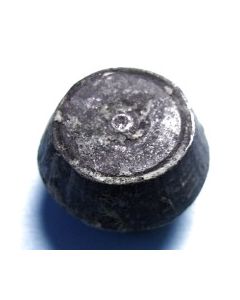 Bronzegewicht, Islamisch, 2 Mithqal
Bronzegewicht, Islamisch, 2 MithqalLevante, 6 Jh. n.Chr. bis 10 Jh. n. Chr., spätbyzantinische bis islamische Epoche. Entsprechende antike Gewichtseinheit: 2 Mithqal (Mitqals).
Price: on request Bronzegewicht, Islamisch, 1 Denar
Bronzegewicht, Islamisch, 1 DenarLevante, 6 Jh. n.Chr. bis 10 Jh. n. Chr., spätbyzantinische bis islamische Epoche. Entsprechende antike Gewichtseinheit: 1 Denar oder ca. 1 Mithqal (Mitqal).
Price: on request Bronzegewicht, Islamisch, 1 Mithqal
Bronzegewicht, Islamisch, 1 MithqalLevante, 6 Jh. n.Chr. bis 10 Jh. n. Chr., spätbyzantinische bis islamische Epoche. Entsprechende antike Gewichtseinheit: 1 Mithqal (Mitqal).
Price: on request Roman jug made of aubergine glass
Roman jug made of aubergine glassBeautiful glass with a violet colour. From the Roman Imperial period.
Price: on request Painted Bronze Age cup
Painted Bronze Age cupThe well preserved Bronze Age pottery bears a geometric painted pattern. Acquired in 1977 at Davies Antiques in London, it is claimed to have been found in Syria.
Price: on request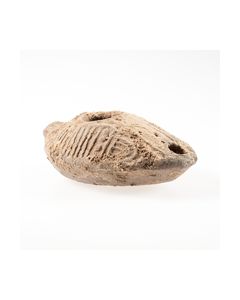 Spätsamaritanische Öllampe mit rundem Einfüllloch
Spätsamaritanische Öllampe mit rundem EinfülllochAuf der Oberseite durch Doppellinie begrenzter Kanal. Mit Halbkreisen, Punkten und Linien verziert.
Price: on request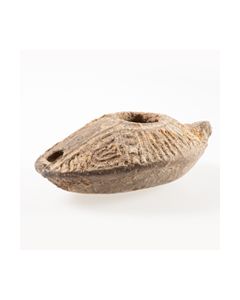 Spätsamaritanische Öllampe mit rundem Einfüllloch
Spätsamaritanische Öllampe mit rundem EinfülllochAuf der Oberseite durch Doppellinie begrenzter Kanal. Mit Halbkreisen, Punkten und Linien verziert.
Price: on request Spätsamaritanische Öllampe mit rundem Einfüllloch
Spätsamaritanische Öllampe mit rundem EinfülllochAuf der Oberseite durch Doppellinie begrenzter Kanal. Mit Halbkreisen, Punkten und Linien verziert.
Price: on request Dekorierte birnenförmige Öllampe
Dekorierte birnenförmige ÖllampeZapfengriff, doppelkonischer Körper, um Füllöffnung hoher Wulstring, weitere tränenförmige Wulst verbindet Henkel und Brennloch.
Price: on request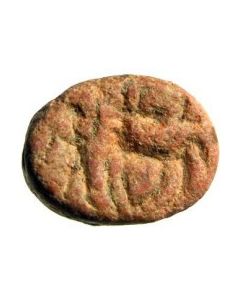 Elamitischer Skarabäus aus Terrakotta
Elamitischer Skarabäus aus TerrakottaSeltenes Terrakottasiegel in vollständiger Erhaltung. Menschen- und Antilopendarstellung auf Siegelfläche. Um 1500 v.Chr., Übergang von Alt- zu Mittelelamitischer Epoche. 15mm lang.
Price: on request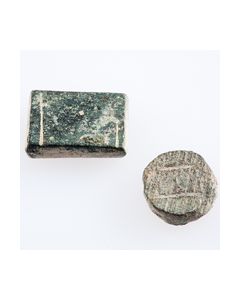 Zwei antike Gewichte aus dem heilgen Land
Zwei antike Gewichte aus dem heilgen LandBronzegewichte, in Plattenform und Scheibenform. 1/4 Schekel und 1/2 Dirhem. Funde aus Israel.
Price: on request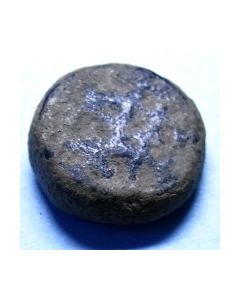 Bronzegewicht, Islamisch, 1 2/3 Mithqal
Bronzegewicht, Islamisch, 1 2/3 MithqalLevante, 6 Jh. n.Chr. bis 10 Jh. n. Chr., spätbyzantinische bis islamische Epoche. Entsprechende antike Gewichtseinheit: 1 und 2/3 Mithqal (Mitqals).
Price: on request Bronzegewicht, Islamisch, 2 Denar
Bronzegewicht, Islamisch, 2 DenarLevante, 6 Jh. n.Chr. bis 10 Jh. n. Chr., spätbyzantinische bis islamische Epoche. Entsprechende antike Gewichtseinheit: 2 Denar (oder ca. 2 Mithqal oder 1/4 Waqiyyah / Uqiyyah).
Price: on request Spätrömische Öllampe
Spätrömische Öllampe3. bis 4. Jh. n.Chr., stilistischer Übergangstyp. Runder Körper mit kunstvollem Dekor aus Punkten, schöne Fundpatina. Museal. Länge 75mm, Breite 55mm
Price: on request Pair of ancient gold earrings
Pair of ancient gold earringsNice example for ancient gold jewellery with elaborate decoration. From the Dr. Neumeister collection.
Price: on request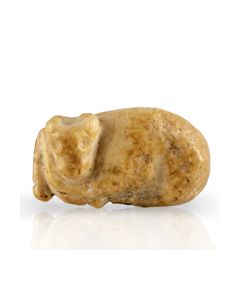 Mesopotamian stamp seal in bull shape
Mesopotamian stamp seal in bull shapeThe perfectly preserved seal is from the Jemdet Nasr period. The stamp shows two goats.
€2,800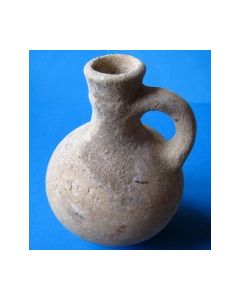 Krug für Wasser oder Wein
Krug für Wasser oder Wein800 v.Chr. bis 586 v.Chr., Eisenzeit II C. Heller, ockerfarbener Ton mit Resten von bichromem Überzug. Perfekt erhaltene Keramik mit toller Sandpatina. Höhe 150mm. Breite maximal 100mm.
Price: on request Spätrömische Öllampe mit rundem Körper
Spätrömische Öllampe mit rundem Körper3. bis 4. Jh. n.Chr., stilistischen Übergangstyp zu den Anfängen der byzantinischen Epoche. Rötliche Keramik mit Pfeilspitzendekor. Länge 95mm, Breite 75mm.
Price: on request Ungereinigte seleukidische Münzen
Ungereinigte seleukidische MünzenMünzen des Seleukid. Reiches, 2. und 3. Jahrhudnert v.Chr., Fundort: heutiges Israel (historisch Palästina, heiliges Land).
Price: on request Pair of ancient gold earrings
Pair of ancient gold earringsInteresting specimen with coil-like biconical cylinder and blue beads. From the first centuries AD, made in the eastern Mediterranean.
Price: on request Painted Bronze Age jug
Painted Bronze Age jugThe clay jug is decorated by an impressively well preserved geometric design. From Bronze Age Anatolia.
Price: on request Pyramidal stamp seal
Pyramidal stamp sealMade from beautiful light green stone during the early Iron Age. The seal is from northern Syria or southern Anatolia and bears an abstract depiction of a stag.
Price: on request Antiker Spinnwirtel aus Judaea
Antiker Spinnwirtel aus JudaeaSpinnwirtel aus Blei. Ca. 1. bis 3. Jh. n. Chr., römische Zeit. Fund aus Israel. Gewicht 8,76 Gramm.
Price: on request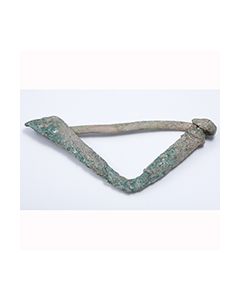 Dreiecksfibel aus der Eisenzeit
Dreiecksfibel aus der EisenzeitAntike Fibel aus Bronze, 800 v.Chr. bis 600 v.Chr, Nadel restauriert. Fibeltyp von der Levante.
Price: on request Roman ribbed glass bowl
Roman ribbed glass bowlOf beautiful, thick-walled glass of a bright light green color. The glass was mold made in a Roman factory of the eastern Mediterranean.
Price: on request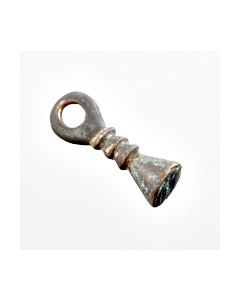 Western Iranian bronze stamp seal
Western Iranian bronze stamp sealInteresting bronze seal showing a bird and glyphs. From a collection of Iranian ancient artefacts.
Price: on request Decorative pin from Luristan
Decorative pin from LuristanThe pin head is shaped like an open basket with a decorative knob. Bronze with attractive patina.
Price: on request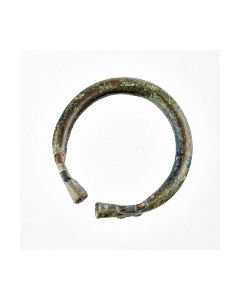 Bracelet from Luristan with animal terminals
Bracelet from Luristan with animal terminalsA high degree of abstraction for the animal heads and a wonderful blue patina make this piece a highlight for Iranian bronze works.
Price: on request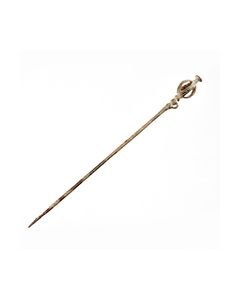 Large decorative pin from Luristan
Large decorative pin from LuristanThe pin head is shaped like an open basket with a decorative knob. Bronze with attractive patina.
Price: on request Blauer Skarabäus aus Israel
Blauer Skarabäus aus IsraelSkarabäusförmiges Siegel aus türkiser Fayence. Stempelfläche mit Käfer-, Nefer- und Nebsymbolen. 7. Jh. v. Chr. bis 5. Jh. v. Chr.
Price: on request Skarabäus des Pharao Siamun
Skarabäus des Pharao SiamunSkarabäusförmiges Siegel aus Israel. Stempelfläche mit hieroglyphischer Inschrift Siamun. 10. Jh. v. Chr.
Price: on request Römischer Goldschmuck
Römischer Goldschmuck2 Ohrringe aus Gold in zypro-mykenischem Stil. Römischer Schmuck aus den östlichen Provinzen, 1 v. Chr. bis 1 n. Chr. Körper in Schlauchform.
Price: on request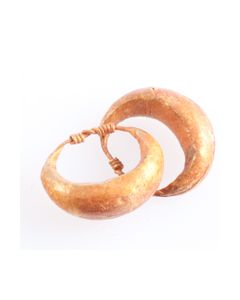 Römischer Goldschmuck
Römischer Goldschmuck2 Ohrringe aus Gold in zypro-mykenischem Stil. Römischer Schmuck aus den östlichen Provinzen, 1 v. Chr. bis 1 n. Chr. Körper in Schlauchform mit linearen Zierrillen.
Price: on request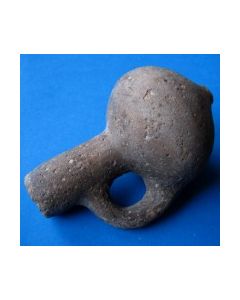 Henkelkrug mit grauem Überzug
Henkelkrug mit grauem ÜberzugCharakteristischer Typ schwarzer Keramiken. 1000 v.Chr. bis 586 v.Chr., Eisenzeit II, Levante. Gebrannter Überzug auf ockerfarbenem Ton, museale Erhaltung. Höhe 95mm.
Price: on request Luristan ceremonial pick
Luristan ceremonial pickThe elaborate decorations are contrary to the actual use as a pick. The object is from the class of pseudo tools common in Iran at the end of the 2nd millenium BC. It probably served a ritualistic purpose.
Price: on request Published bracelet with Luristan ram heads
Published bracelet with Luristan ram headsNicely worked zoomorphic terminals with close parallels to achaemenide art. Dating to the early 1st Millenium BC.
Price: on request

